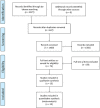Effects of Aortic Valve Replacement on Severe Aortic Stenosis and Preserved Systolic Function: Systematic Review and Network Meta-analysis
- PMID: 28698585
- PMCID: PMC5505951
- DOI: 10.1038/s41598-017-05021-9
Effects of Aortic Valve Replacement on Severe Aortic Stenosis and Preserved Systolic Function: Systematic Review and Network Meta-analysis
Abstract
The survival benefits of aortic valve replacement (AVR) in the different flow-gradient states of severe aortic stenosis (AS) is not known. A comprehensive search in PubMed/MEDLINE, Embase, Cochrane Library, CNKI and OpenGrey were conducted to identify studies that investigated the prognosis of severe AS (effective orifice area ≤1.0 cm2) and left ventricular ejection fraction ≥50%. Severe AS was stratified by mean pressure gradient [threshold of 40 mmHg; high-gradient (HG) and low-gradient (LG)] and stroke volume index [threshold of 35 ml/m2; normal-flow (NL) and low-flow (LF)]. Network meta-analysis was conducted to assess all-cause mortality among each AS sub-type with rate ratio (RR) reported. The effects of AVR on prognosis were examined using network meta-regression. In the pooled analysis (15 studies and 9,737 patients), LF states (both HG and LG) were associated with increased mortality rate (LFLG: RR 1.88; 95% CI: 1.43-2.46; LFHG: RR: 1.77; 95% CI: 1.16-2.70) compared to moderate AS; and NF states in both HG and LG had similar prognosis as moderate AS (NFLG: RR 1.11; 95% CI: 0.81-1.53; NFHG: RR 1.16; 95% CI: 0.82-1.64). AVR conferred different survival benefits: it was most effective in NFHG (RR with AVR /RR without AVR : 0.43; 95% CI: 0.22-0.82) and least in LFLG (RR with AVR /RR without AVR : 1.19; 95% CI: 0.74-1.94).
Conflict of interest statement
The authors declare that they have no competing interests.
Figures






Similar articles
-
Impact of Surgical and Transcatheter Aortic Valve Replacement in Low-Gradient Aortic Stenosis: A Meta-Analysis.JACC Cardiovasc Interv. 2021 Jul 12;14(13):1481-1492. doi: 10.1016/j.jcin.2021.04.038. Epub 2021 May 3. JACC Cardiovasc Interv. 2021. PMID: 33939605
-
Integration of Flow-Gradient Patterns Into Clinical Decision Making for Patients With Suspected Severe Aortic Stenosis and Preserved LVEF: A Systematic Review of Evidence and Meta-Analysis.JACC Cardiovasc Imaging. 2016 Nov;9(11):1255-1263. doi: 10.1016/j.jcmg.2016.01.035. Epub 2016 Aug 17. JACC Cardiovasc Imaging. 2016. PMID: 27544900
-
Early Stroke Volume Variation After Transcatheter or Surgical Aortic Valve Replacement Predicts Clinical Outcomes in Low-Flow Aortic Stenosis.Catheter Cardiovasc Interv. 2025 Aug;106(2):1012-1022. doi: 10.1002/ccd.31654. Epub 2025 Jun 2. Catheter Cardiovasc Interv. 2025. PMID: 40457610 Free PMC article.
-
Low-Gradient Severe Aortic Stenosis: Insights From the CURRENT AS Registry-2.JACC Cardiovasc Interv. 2025 Feb 24;18(4):471-487. doi: 10.1016/j.jcin.2024.09.044. Epub 2024 Dec 18. JACC Cardiovasc Interv. 2025. PMID: 39708011
-
Efficacy of transcatheter aortic valve implantation in patients with aortic stenosis and reduced LVEF. A systematic review.Herz. 2015 Apr;40 Suppl 2:168-80. doi: 10.1007/s00059-014-4193-z. Epub 2015 Feb 26. Herz. 2015. PMID: 25712464
Cited by
-
Prognosis of Paradoxical Low-Flow Low-Gradient Aortic Stenosis: A Severe, Non-critical Form, With Surgical Treatment Benefits.Front Cardiovasc Med. 2022 Apr 1;9:852954. doi: 10.3389/fcvm.2022.852954. eCollection 2022. Front Cardiovasc Med. 2022. PMID: 35433871 Free PMC article.
-
Management of aortic stenosis: a systematic review of clinical practice guidelines and recommendations.Eur Heart J Qual Care Clin Outcomes. 2021 Jul 21;7(4):340-353. doi: 10.1093/ehjqcco/qcab016. Eur Heart J Qual Care Clin Outcomes. 2021. PMID: 33751049 Free PMC article.
-
Percutaneous versus Surgical Intervention for Severe Aortic Valve Stenosis: A Systematic Review.Biomed Res Int. 2021 May 26;2021:3973924. doi: 10.1155/2021/3973924. eCollection 2021. Biomed Res Int. 2021. PMID: 34136565 Free PMC article.
-
Impaired Left Ventricular Circumferential Midwall Systolic Performance Appears Linked to Depressed Preload, but Not Intrinsic Contractile Dysfunction or Excessive Afterload, in Paradoxical Low-Flow/Low-Gradient Severe Aortic Stenosis.J Clin Med. 2022 May 19;11(10):2873. doi: 10.3390/jcm11102873. J Clin Med. 2022. PMID: 35628998 Free PMC article.
-
Low-gradient severe aortic stenosis with preserved ejection fraction: how fast should we act?Int J Cardiovasc Imaging. 2021 Nov;37(11):3177-3180. doi: 10.1007/s10554-021-02396-9. Epub 2021 Sep 17. Int J Cardiovasc Imaging. 2021. PMID: 34533650 No abstract available.
References
Publication types
MeSH terms
LinkOut - more resources
Full Text Sources
Other Literature Sources
Research Materials

